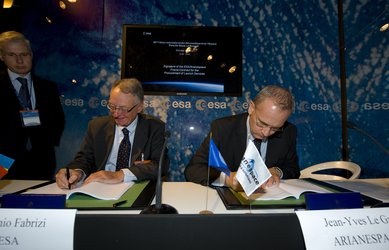Another dual launch for Ariane 5
Last night, an Ariane 5 ECA launcher lifted off from Europe’s Spaceport in French Guiana on a journey to place two telecommunications satellites,
Liftoff of the 48th Ariane 5 mission took place at the start of the launch window: 21:00 CET (20:00 UTC; 17:00 French Guiana). The target injection orbit had a perigee altitude of 250 km, an apogee altitude at injection of 35 786 km and an inclination of 6º. The satellites were accurately injected into their transfer orbits about 27 and 31 minutes after liftoff, respectively.
NSS-12 will be located at 57°E and provide direct-to-home coverage using four regional
Thor 6 will be located at 1°W and deliver high-power, direct-to-home television services using
The payload mass for this launch was 9462 kg; the satellite masses totalled 8671 kg, with payload adapters and dispensers making up the additional 791 kg.
Arianespace and Europe’s Spaceport are planning seven Ariane launches during 2009, maintaining the heavy-lift vehicle’s flight rate. The ability to sustain high launch rates has already been demonstrated: during the
Initial construction of the Ariane 5 GS launcher for the seventh flight has been completed and the vehicle stands ready in the Launcher Integration Building (Bâtiment d’Intégration Lanceur; BIL) to be transferred to the Final Assembly Building (Bâtiment d’Assemblage Final; BAF) now it has been vacated by the rollout of V192.
Flight timeline
The Ariane 5’s cryogenic, liquid-propellant main engine was ignited first. Seven seconds later, the solid-propellant boosters were also fired, and the vehicle lifted off a fraction of a second later.
The solid boosters were jettisoned 2 min 21 sec after main engine ignition, and the fairing protecting the payload during the climb through Earth’s atmosphere was discarded at 3 min 9 sec. The launcher’s main engine was shut down at 8 min 52 sec; six seconds later, the main cryogenic stage separated from the upper stage and its payload.
Four seconds after main stage separation, the engine of the cryogenic upper stage was ignited to continue the journey. The engine was shut down at 24 min 45 sec into the flight, at which point the vehicle was travelling at 9400 m/s (33 840 km/h) at an altitude of 600 km. The conditions for geostationary transfer orbit injection had been achieved.
At 26 min 36 sec after main engine ignition,














